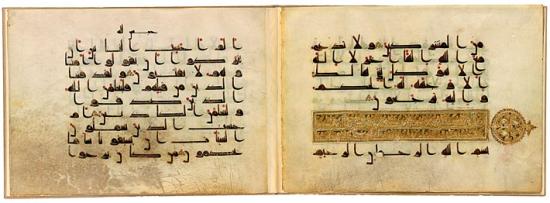
Fragment from an Early Tenth-Century Qur˒an
Qur˒an fragment, in Arabic
Purchased by J. P. Morgan, Jr., 1915
Although the earliest vellum Qur˒ans (late seventh to eighth centuries) were vertical in format, those of the ninth to eleventh centuries were oblong, perhaps inspired by the Kufic script, and featured oblong panels inscribed with Qur˒anic verses. Other folios from this manuscript are preserved in the Chester Beatty Library, Dublin, the Topkapi Palace Museum, Istanbul, and elsewhere, one stating that ˓Abd al-Mun˓im Ibn Aḥmad donated the Qur˒an to the Great Mosque of Damascus during July 911. The Morgan fragment contains suras 27 to 29. Shown here is the heading for sura 29 (al-˓Ankabūt, or "The Spider"), which is written in gold. The name is derived from those who, taking protectors other than Allah, are likened to spiders who build flimsy homes. The diacriticals consist of short diagonal lines, and red dots indicate vocalizations. Pyramids of six gold discs mark the ends of ayat (verses).
The Qur˒an, the Holy Book of Islam
From a monumental volume used in an Istanbul mosque to a miniature Persian version that served as a talisman, this section features examples of illuminated pages from the holy book of Islam. The Qur˒an (to recite) represents the codification of the words of God that were revealed and transmitted through the angel Gabriel to the prophet Muḥammad (ca. 570–632) over a period of twenty-three years. The visions began in 610 in a cave on Mount Hira near Mecca, his birthplace, and continued after his 622 flight to Medina, until his death. His flight—the Hijra—marks the beginning of the Islamic calendar.
The revelations were arranged into 114 suras (chapters), each named after its theme. The first and shortest ones, at the end of the book, from the Meccan period, establish Muḥammad as the final prophet in a line of monotheists, including Abraham and Jesus. The longest suras, placed at the beginning, are Medinan and deal more with social and political issues.
For centuries, Qur˒ans were written in Arabic, the language of transmission. After Muḥammad's death, his cousin ˓Alī and others compiled the revelations into a text. About twenty years later, under Uthman, the third caliph (644–656) succeeding Muḥammad, a standard version of the Qur˒an —essentially the one used today—was produced. Thereafter Islam (which means "surrender to God") spread from the Arabian Peninsula throughout the Middle East, to northern Africa and southern Spain, and eventually the world.
